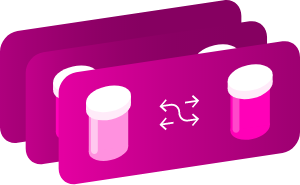口服溶瘤和抗逆转录病毒治疗管理:剂量调整,药物相互作用,和临床使用的其他考虑因素。
文章的细节
-
引用
复制到剪贴板 -
张志刚,张志刚,张志刚
口服溶瘤和抗逆转录病毒治疗管理:剂量调整,药物相互作用,和临床使用的其他考虑因素。
2019年2月13日;8点212550。doi: 10.7573 / dic.212550。eCollection 2019。
- PubMed ID
-
30815023 (PubMed视图]
- 摘要
-
非艾滋病定义的癌症(NADCs)的增加正在成为艾滋病毒和癌症患者死亡的主要原因。为了解决这一问题,目前的文献和指南建议继续抗逆转录病毒治疗(ART)与口服溶瘤剂,以预防与艾滋病毒疾病进展相关的不良并发症。然而,这种方法有药物-药物相互作用和不良事件的患者在这种治疗的潜力。此外,关于如何调整这些药物,当同时使用时,是有限的。因此,我们的目的是通过药物数据库(如Micromedex, Lexi-Comp等)和包装插入以及PubMed/Medline, Embase和谷歌Scholar数据库等手段评估现有文献,以开发一个参考工具,供提供者在决定同时使用ART和口服溶瘤药物治疗患者时使用。我们的研究结果表明,有许多药物相互作用,应该考虑到双重治疗。代谢是剂量调整的关键决定因素,许多溶瘤药物和抗逆转录病毒治疗药物必须进行剂量调整。最值得注意的是,几种酪氨酸激酶抑制剂与非核苷类逆转录酶抑制剂(NNRTIs)联合使用时需要增加剂量,但与蛋白酶抑制剂(pi)和cobicistat联合使用时必须减少剂量。进一步的研究结果表明,某些药物不应联合使用,包括但不限于博舒替尼与NNRTIs、cobicistat或pi的联合使用;idelalisib与马拉韦洛克或PIs合用; neratinib with NNRTIs, cobicistat, or PIs; and venetoclax with NNRTIs. Overall, the most prominent oncolytic drug interactions were discovered when such agents were used concomitantly with PIs, cobicistat-boosted elvitegravir, or NNRTIs. Future studies are necessary to further evaluate the use of these agents together in disease therapy to generate absolute evidence of such findings. However, from the studies evaluated, much evidence exists to suggest that concomitant therapy is not without drug interactions. As such, clinical decisions regarding concomitant therapy should be evaluated in which the risk and benefit of dual therapy are assessed. Dose adjustments must be made accordingly and in consultation with both HIV and oncology clinicians and pharmacists to reduce the risk for adverse outcomes and disease progression for those with cancer and HIV/AIDS.
引用本文的药物库数据
- 药物酶
-
药物 酶 种类 生物 药理作用 行动 依托泊苷 细胞色素P450 3A4 蛋白质 人类 未知的底物抑制剂诱导物细节 Nilutamide 细胞色素P450 2C19 蛋白质 人类 未知的底物抑制剂细节 - 药物的相互作用Learn More" title="" id="structured-interactions-info" class="drug-info-popup" href="javascript:void(0);">
-
药物 交互 整合药物之间
软件中的交互Everolimus 依法韦伦 依维莫司与依非韦伦合用可降低血药浓度。
